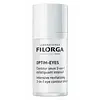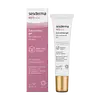What's inside
What's inside
 Key Ingredients
Key Ingredients

 Benefits
Benefits

 Concerns
Concerns

 Ingredients Side-by-side
Ingredients Side-by-side

Water
Skin ConditioningGlycerin
HumectantCaprylic/Capric Triglyceride
MaskingC12-16 Alcohols
EmollientCyclopentasiloxane
EmollientPEG-8
HumectantPolyacrylate-13
Hydrogenated Lecithin
EmulsifyingPalmitic Acid
EmollientPrunus Domestica Seed Oil
Skin ConditioningPolyisobutene
Cyclohexasiloxane
EmollientSucrose Palmitate
EmollientParfum
MaskingDimethicone Crosspolymer
Emulsion StabilisingSteareth-20
CleansingCaprylyl Glycol
EmollientChlorphenesin
AntimicrobialHesperidin Methyl Chalcone
AntioxidantTetrasodium EDTA
Glyceryl Linoleate
EmollientPolysorbate 20
EmulsifyingTromethamine
BufferingPrunus Amygdalus Dulcis Oil
Skin ConditioningSodium Chloride
MaskingSodium Polyacrylate
AbsorbentChlorhexidine Digluconate
AntimicrobialGlucose
HumectantPhenoxyethanol
PreservativeSodium Hyaluronate
HumectantPotassium Sorbate
PreservativeCitric Acid
BufferingN-Hydroxysuccinimide
Skin ConditioningPotassium Chloride
Dipeptide-2
Skin ConditioningCalcium Chloride
AstringentMagnesium Sulfate
Glutamine
Skin ConditioningSodium Phosphate
BufferingPalmitoyl Tetrapeptide-7
Skin ConditioningAscorbic Acid
AntioxidantSodium Acetate
BufferingTocopherol
AntioxidantLysine Hcl
Skin ConditioningArginine
MaskingAlanine
MaskingHistidine
HumectantValine
MaskingChrysin
Skin ConditioningPalmitoyl Oligopeptide
CleansingLeucine
Skin ConditioningThreonine
Isoleucine
Skin ConditioningTryptophan
MaskingPhenylalanine
MaskingTyrosine
MaskingGlycine
BufferingPolysorbate 80
EmulsifyingSerine
Masking2'-Deoxyadenosine
Cystine
MaskingCyanocobalamin
Skin ConditioningDeoxycytidine
Deoxyguanosine
Thymidine
Skin ConditioningGlutathione
Asparagine
MaskingAspartic Acid
MaskingOrnithine
Skin ConditioningGlutamic Acid
HumectantNicotinamide Adenine Dinucleotide
Skin ConditioningProline
Skin ConditioningAminobutyric Acid
Methionine
Skin ConditioningTaurine
BufferingHydroxyproline
Skin ConditioningGlucosamine
Coenzyme A
Skin ConditioningGlucuronolactone
Skin ConditioningSodium Glucuronate
HumectantThiamine Diphosphate
Skin ConditioningDisodium Flavine Adenine Dinucleotide
Sodium Trimetaphosphate
BufferingRetinyl Acetate
Skin ConditioningInositol
HumectantNiacin
SmoothingNiacinamide
SmoothingPyridoxal 5-Phosphate
Skin ConditioningPyridoxine
Skin ConditioningBiotin
AntiseborrhoeicCalcium Pantothenate
Folic Acid
Skin ConditioningRiboflavin
Cosmetic ColorantTocopheryl Phosphate
CleansingWater, Glycerin, Caprylic/Capric Triglyceride, C12-16 Alcohols, Cyclopentasiloxane, PEG-8, Polyacrylate-13, Hydrogenated Lecithin, Palmitic Acid, Prunus Domestica Seed Oil, Polyisobutene, Cyclohexasiloxane, Sucrose Palmitate, Parfum, Dimethicone Crosspolymer, Steareth-20, Caprylyl Glycol, Chlorphenesin, Hesperidin Methyl Chalcone, Tetrasodium EDTA, Glyceryl Linoleate, Polysorbate 20, Tromethamine, Prunus Amygdalus Dulcis Oil, Sodium Chloride, Sodium Polyacrylate, Chlorhexidine Digluconate, Glucose, Phenoxyethanol, Sodium Hyaluronate, Potassium Sorbate, Citric Acid, N-Hydroxysuccinimide, Potassium Chloride, Dipeptide-2, Calcium Chloride, Magnesium Sulfate, Glutamine, Sodium Phosphate, Palmitoyl Tetrapeptide-7, Ascorbic Acid, Sodium Acetate, Tocopherol, Lysine Hcl, Arginine, Alanine, Histidine, Valine, Chrysin, Palmitoyl Oligopeptide, Leucine, Threonine, Isoleucine, Tryptophan, Phenylalanine, Tyrosine, Glycine, Polysorbate 80, Serine, 2'-Deoxyadenosine, Cystine, Cyanocobalamin, Deoxycytidine, Deoxyguanosine, Thymidine, Glutathione, Asparagine, Aspartic Acid, Ornithine, Glutamic Acid, Nicotinamide Adenine Dinucleotide, Proline, Aminobutyric Acid, Methionine, Taurine, Hydroxyproline, Glucosamine, Coenzyme A, Glucuronolactone, Sodium Glucuronate, Thiamine Diphosphate, Disodium Flavine Adenine Dinucleotide, Sodium Trimetaphosphate, Retinyl Acetate, Inositol, Niacin, Niacinamide, Pyridoxal 5-Phosphate, Pyridoxine, Biotin, Calcium Pantothenate, Folic Acid, Riboflavin, Tocopheryl Phosphate
Water
Skin ConditioningCaprylic/Capric Triglyceride
MaskingIsostearyl Isostearate
EmollientPropanediol
SolventPentylene Glycol
Skin ConditioningPEG-100 Stearate
Glyceryl Stearate
EmollientPropylene Glycol
HumectantGlycerin
HumectantNicotiana Benthamiana Hexapeptide-40 Sh-Polypeptide-76
Skin ConditioningNicotiana Benthamiana Sh-Polypeptide-15 Hexapeptide-40
Skin ConditioningAesculus Hippocastanum Bark Extract
AstringentAlcohol
AntimicrobialAlpha-Arbutin
AntioxidantAscorbyl Glucoside
AntioxidantBHA
AntioxidantBHT
AntioxidantButylene Glycol
HumectantCamphanediol
Skin ConditioningCaprooyl Tetrapeptide-3
Skin ProtectingCarbomer
Emulsion StabilisingCetearyl Alcohol
EmollientCI 17200
Cosmetic ColorantDextran
Dipotassium Phosphate
BufferingDisodium EDTA
Ergothioneine
AntioxidantEthylhexylglycerin
Skin ConditioningGinkgo Biloba Leaf Extract
Skin ConditioningGlycine Soja Protein
EmulsifyingHelianthus Annuus Seed Oil
EmollientHydrochloric Acid
BufferingHydrolyzed Rice Bran Protein
Skin ConditioningHydrolyzed Sodium Hyaluronate
Skin ConditioningLecithin
EmollientParfum
MaskingPhenoxyethanol
PreservativePinanediol
Skin ConditioningPolysorbate 20
EmulsifyingPotassium Phosphate
BufferingPotassium Sorbate
PreservativeResveratrol Dimethyl Ether
AntioxidantRetinal
Skin ConditioningRetinol
Skin ConditioningRetinyl Propionate
Skin ConditioningSodium Benzoate
MaskingSodium Chloride
MaskingSodium Cholate
Skin ConditioningSodium Dextran Sulfate
Gel FormingSodium Hydroxide
BufferingSuperoxide Dismutase
AntioxidantTriethanolamine
BufferingTromethamine
BufferingZinc Chloride
AntimicrobialWater, Caprylic/Capric Triglyceride, Isostearyl Isostearate, Propanediol, Pentylene Glycol, PEG-100 Stearate, Glyceryl Stearate, Propylene Glycol, Glycerin, Nicotiana Benthamiana Hexapeptide-40 Sh-Polypeptide-76, Nicotiana Benthamiana Sh-Polypeptide-15 Hexapeptide-40, Aesculus Hippocastanum Bark Extract, Alcohol, Alpha-Arbutin, Ascorbyl Glucoside, BHA, BHT, Butylene Glycol, Camphanediol, Caprooyl Tetrapeptide-3, Carbomer, Cetearyl Alcohol, CI 17200, Dextran, Dipotassium Phosphate, Disodium EDTA, Ergothioneine, Ethylhexylglycerin, Ginkgo Biloba Leaf Extract, Glycine Soja Protein, Helianthus Annuus Seed Oil, Hydrochloric Acid, Hydrolyzed Rice Bran Protein, Hydrolyzed Sodium Hyaluronate, Lecithin, Parfum, Phenoxyethanol, Pinanediol, Polysorbate 20, Potassium Phosphate, Potassium Sorbate, Resveratrol Dimethyl Ether, Retinal, Retinol, Retinyl Propionate, Sodium Benzoate, Sodium Chloride, Sodium Cholate, Sodium Dextran Sulfate, Sodium Hydroxide, Superoxide Dismutase, Triethanolamine, Tromethamine, Zinc Chloride
Ingredients Explained
These ingredients are found in both products.
Ingredients higher up in an ingredient list are typically present in a larger amount.
This ingredient is an emollient, solvent, and texture enhancer. It is considered a skin-softener by helping the skin prevent moisture loss.
It helps thicken a product's formula and makes it easier to spread by dissolving clumping compounds.
Caprylic Triglyceride is made by combining glycerin with coconut oil, forming a clear liquid.
While there is an assumption Caprylic Triglyceride can clog pores due to it being derived from coconut oil, there is no research supporting this.
Learn more about Caprylic/Capric TriglycerideGlycerin is already naturally found in your skin. It helps moisturize and protect your skin.
A study from 2016 found glycerin to be more effective as a humectant than AHAs and hyaluronic acid.
As a humectant, it helps the skin stay hydrated by pulling moisture to your skin. The low molecular weight of glycerin allows it to pull moisture into the deeper layers of your skin.
Hydrated skin improves your skin barrier; Your skin barrier helps protect against irritants and bacteria.
Glycerin has also been found to have antimicrobial and antiviral properties. Due to these properties, glycerin is often used in wound and burn treatments.
In cosmetics, glycerin is usually derived from plants such as soybean or palm. However, it can also be sourced from animals, such as tallow or animal fat.
This ingredient is organic, colorless, odorless, and non-toxic.
Glycerin is the name for this ingredient in American English. British English uses Glycerol/Glycerine.
Learn more about GlycerinParfum is a catch-all term for an ingredient or more that is used to give a scent to products.
Also called "fragrance", this ingredient can be a blend of hundreds of chemicals or plant oils. This means every product with "fragrance" or "parfum" in the ingredients list is a different mixture.
For instance, Habanolide is a proprietary trade name for a specific aroma chemical. When used as a fragrance ingredient in cosmetics, most aroma chemicals fall under the broad labeling category of “FRAGRANCE” or “PARFUM” according to EU and US regulations.
The term 'parfum' or 'fragrance' is not regulated in many countries. In many cases, it is up to the brand to define this term.
For instance, many brands choose to label themselves as "fragrance-free" because they are not using synthetic fragrances. However, their products may still contain ingredients such as essential oils that are considered a fragrance by INCI standards.
One example is Calendula flower extract. Calendula is an essential oil that still imparts a scent or 'fragrance'.
Depending on the blend, the ingredients in the mixture can cause allergies and sensitivities on the skin. Some ingredients that are known EU allergens include linalool and citronellol.
Parfum can also be used to mask or cover an unpleasant scent.
The bottom line is: not all fragrances/parfum/ingredients are created equally. If you are worried about fragrances, we recommend taking a closer look at an ingredient. And of course, we always recommend speaking with a professional.
Learn more about ParfumPhenoxyethanol is a preservative that has germicide, antimicrobial, and aromatic properties. Studies show that phenoxyethanol can prevent microbial growth. By itself, it has a scent that is similar to that of a rose.
It's often used in formulations along with Caprylyl Glycol to preserve the shelf life of products.
Polysorbate 20 is made by combining ethoxylation of sorbitan, ethylene oxide, and lauric acid. It is a mild cleansing agent, surfactant, and emulsifier.
As a surfactant, it helps collect dirt and oils for washing. Emulsifiers prevent oils and water from separating.
Polysorbate 20 also adds scent to a product. Since it is made using sorbitol, it has a sweet scent. Sorbitol can also be found in fruits such as apples and peaches.
The lauric acid used to create Polysorbate 20 is often derived from coconuts.
Polysorbate 20 may not be fungal acne safe.
Learn more about Polysorbate 20Potassium Sorbate is a preservative used to prevent yeast and mold in products. It is commonly found in both cosmetic and food products.
This ingredient comes from potassium salt derived from sorbic acid. Sorbic acid is a natural antibiotic and effective against fungus.
Both potassium sorbate and sorbic acid can be found in baked goods, cheeses, dried meats, dried fruit, ice cream, pickles, wine, yogurt, and more.
You'll often find this ingredient used with other preservatives.
Learn more about Potassium SorbateChances are, you eat sodium chloride every day. Sodium Chloride is also known as table salt.
This ingredient has many purposes in skincare: thickener, emulsifier, and exfoliator.
You'll most likely find this ingredient in cleansers where it is used to create a gel-like texture. As an emulsifier, it also prevents ingredients from separating.
There is much debate on whether this ingredient is comedogenic. The short answer - comedogenic ratings don't tell the whole story. Learn more about comegodenic ratings here.
The concensus about this ingredient causing acne seems to be divided. Research is needed to understand if this ingredient does cause acne.
Scrubs may use salt as the primary exfoliating ingredient.
Learn more about Sodium ChlorideTromethamine helps balance the pH and improve the texture of a product. It is synthetically created.
As an emulsifier, Tromethamine prevents oil and water ingredients from separating. This helps stabilize the product and elongate a product's shelf life. Tromethamine also makes a product thicker.
Tromethamine helps balance the pH level of a product. Normal pH level of skin is slightly acidic (~4.75-5.5). The acidity of our skin is maintained by our glands and skin biome. Being slightly acidic allows our skin to create an "acid mantle". This acid mantle is a thin barrier that protects our skin from bacteria and contaminants.
Oral Tromethanmine is an anti-inflammatory drug but plays the role of masking, adding fragrance, and/or balancing pH in skincare.
1,3-Propanediol, 2-amino-2-(hydroxymethyl)-
Learn more about TromethamineWater. It's the most common cosmetic ingredient of all. You'll usually see it at the top of ingredient lists, meaning that it makes up the largest part of the product.
So why is it so popular? Water most often acts as a solvent - this means that it helps dissolve other ingredients into the formulation.
You'll also recognize water as that liquid we all need to stay alive. If you see this, drink a glass of water. Stay hydrated!
Learn more about Water